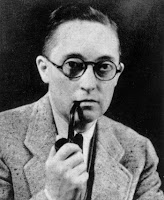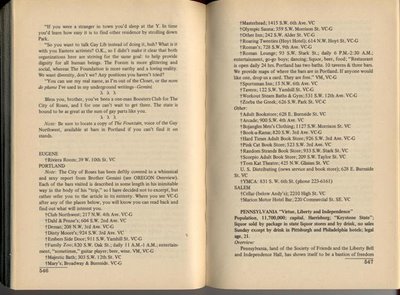 PHOTO: Alan L. Hart, shown in 1943, grew up in Albany, Oregon (across the river from Corvallis, Oregon State University) as Alberta Lucille Hart and is considered to be an early example of an FTM or female-to-male. Early gay historians controversially categorized Hart as a lesbian. (See previous posts Albany, Oregon FTM Alan Hart 1890-1962 (9/3/11), Jonathan Ned Katz gay history pioneer (3/6/10) and Alan L. Hart (Wikipedia))
PHOTO: Alan L. Hart, shown in 1943, grew up in Albany, Oregon (across the river from Corvallis, Oregon State University) as Alberta Lucille Hart and is considered to be an early example of an FTM or female-to-male. Early gay historians controversially categorized Hart as a lesbian. (See previous posts Albany, Oregon FTM Alan Hart 1890-1962 (9/3/11), Jonathan Ned Katz gay history pioneer (3/6/10) and Alan L. Hart (Wikipedia))
The female-to-male or FTM Dr. Alan Hart's 1925 marriage to a woman would have likely been considered illegal under prior Oregon laws that defined marriage between one man and one woman, with gender defined by their biological sex assigned at birth. However, today Hart's marriage is clearly legal given changes in Oregon laws and the recent decision in favor of gay marriage by the U.S. Supreme Court.
Interestingly, Dr. Alan Hart's 1925 marriage and the Supreme Court's 1972 "Baker v. Nelson" decision were mentioned in the Portland, Oregon LGBT newspaper: "PQ Monthly July/August 2015 Edition" PQ pqmonthly.com posted July 15, 2015 (Download PDF of PQ July/August 2015 edition). See quotes and page references below:
June 26, 2015. Do you remember where you were when the Supreme Court ruled -- 5-4 -- that states cannot keep same-sex couples from marrying, and all states must recognize same-sex unions? June 26, the day the 103-page Obergefell v. Hodges was handed down, is a new Stonewall of sorts -- a spectacular day for LGBTQ people -- and, in fact, all Americans. Despite pockets of resistance, gay marriage is now simply marriage -- and it's the law of the land. PQ has been collecting responses from local LGBTQ leaders, folks who've dedicated their lives to the movement.
Mark Johnson Roberts is a family law attorney for Gevurtz Menashe and has been a legal advocate for Oregon's gay and lesbian citizens since 1991; he is former president of the Oregon State Bar as well as the Oregon Gay and Lesbian Law Association. Roberts writes: . . .
"Some will complain that the Court's decision has foreclosed further debate on this issue, but truthfully, there is no further debate to be had. The national conversation about same-sex marriage, which began as long ago as the Court's contrary 1972 decision in Baker v. Nelson, has ended as it must always have ended, . . ."
(Quoted from Daniel Bergen, "#LOVEWON; Marriage is ours," PQ (Portland, Oregon) Jul.-Aug. 2015, p. 12)
In the same issue of PQ, Robin Will, President, GLAPN, recalled Dr. Alan Hart's 1925 marriage:
Hart graduated from University of Oregon Medical School in 1917, underwent a hysterectomy, and lived as Dr. Alan L. Hart until his death in 1962, writing novels, building a career in radiology and public health, and marrying twice along the way.
His is the first documented transgender male transition in the United States.
It is clear that Alan Hart intended to be remembered as a man. On his instruction, his personal letters and photos in a safe deposit box were destroyed after his death. His widow, Edna Ruddick Hart, whom he married in 1925, was likewise reticent, refusing interviews until her own death in 1982. On the record, the Harts were a prosperous, childless couple: a successful doctor/researcher and his wife, enjoying Edna's extended family, joining the ACLU, and serving in their Unitarian Church. . .
Hart almost got away with it. Connecticut was a long ways from Oregon, and at the time of Hart's death in 1962, the time was not yet ripe for histories celebrating sexual minorities. However, apparently there were some loose ends somewhere, and Alan (formerly Lucille) Hart showed up on the gaydar of a New York-based historian, Jonathan Katz. Hart was outed -- as a lesbian! -- in Katz' Gay American History: Lesbians and Gay Men in the U.S.A., published in 1976. . . .
Hart had left a substantial paper trail in Oregon. He attended high school in Albany; he had attended Albany College (later Lewis & Clark) and, briefly, Stanford, leaving evidence in all three places; he had earned his M.D. under his own name at University of Oregon. Yearbooks and local newspapers had the stories. . .
In the meantime, somebody else was investigating Alan Hart, someone unconcerned with gender politics. Brian Booth, a Portland attorney who knew almost everyone in Oregon fiction, was trying to figure out how Dr. Alan Hart had published four well-reviewed novels set in the northwest without attracting any local notice or leaving a trace of his existence. He probably wouldn't have figured it out if he hadn't stumbled on the Lucille Hart controversy. Booth hired Thomas Lauderdale, fresh from Grant High School and on his way to Harvard, to start investigating Hart's background. They read the novels, collected the reviews, gathered yearbook photos and school literary magazines, and apparently interviewed people who had known Hart as a child. With the eventual help of GLAPN founder Tom Cook, a local trove of Hart data and memorabilia have accumulated-waiting for a historian to sort it out. . . .
Anybody with a Multnomah County library card can read The Oregonian's July 14, 1996 article online. There is an admirably thorough and recently-maintained Wikipedia entry on Alan Hart. GLAPN doesn't know who maintains it. If anyone has investigated Jonathan Katz' research by perusing his personal papers, archived in New York, results have not reached GLAPN yet. Thomas Lauderdale and Tom Cook are the two individuals in Oregon -- aside from the keeper of the Wikipedia article -- who know the most about Alan Hart. Lauderdale is busy playing music. Cook is enjoying his retirement, but GLAPN has all of his notes. It will be interesting to see what happens next. . . .
(Quoted from Robin Will, President, GLAPN, "DR. ALAN HART, UNWITTING QUEER PIONEER," PQ (Portland, Oregon) Jun.-Jul. 2015, p. 24)
(See Alan L. Hart (October 4, 1890 - July 1, 1962) wikipedia.org)




